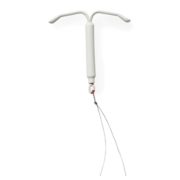Levonorgestrel is one of the longest-studied types of progestin which is the synthetic version of progesterone, a hormone made by the body. And all the scientific evidence to date shows it is super safe. It’s used in hormonal IUDs, some emergency contraception pills, and certain birth control pills.
- Birth control
- IUD
- FAQs
IUD

What is levonorgestrel?
My IUD was expelled. Should I try again?
1. Haven’t been pregnant
2. Are younger than 20 years
3. Have a history of very heavy or very painful periods (though be mindful that these are reasons the hormonal IUD is recommended in the first place…)
4. Had the IUD put in right after giving birth or having an abortion after 14 weeks.
A partial expulsion may mean that the IUD was not quite in the right position: it may have been too low in the uterus and just worked its way out. This could be something that happened around the time of insertion, or may be related to the size, angle, or conditions like fibroids that can cause the uterus to have an irregular shape. For people who have an IUD expulsion, the chance of expelling a second IUD may be higher—in the 20% range (up to 30% in some studies).
If you want a second IUD after the first one came out, consider asking your health care provider about inserting the second IUD while using an ultrasound machine to make sure the IUD is inserted all the way to the top of the uterus where it belongs.
IUD expulsion (when part or all of the IUD comes out after it’s placed in the uterus) can occur in 2-10% of people in the first year after insertion. Expulsion can be more likely for people who:
1. Haven’t been pregnant
2. Are younger than 20 years
3. Have a history of very heavy or very painful periods (though be mindful that these are reasons the hormonal IUD is recommended in the first place…)
4. Had the IUD put in right after giving birth or having an abortion after 14 weeks.
A partial expulsion may mean that the IUD was not quite in the right position: it may have been too low in the uterus and just worked its way out. This could be something that happened around the time of insertion, or may be related to the size, angle, or conditions like fibroids that can cause the uterus to have an irregular shape. For people who have an IUD expulsion, the chance of expelling a second IUD may be higher—in the 20% range (up to 30% in some studies).
If you want a second IUD after the first one came out, consider asking your health care provider about inserting the second IUD while using an ultrasound machine to make sure the IUD is inserted all the way to the top of the uterus where it belongs.
Want to learn more?
How soon does an IUD become effective after you get it?
The non-hormonal IUD and two of the brands of the hormonal IUD (Liletta and Mirena) are effective immediately after they’re inserted. They actually work as very effective emergency contraception, preventing pregnancy from sex you’ve had in the 5 days before they are placed! The other hormonal IUDs, Kyleena and Skyla, are effective immediately if you get it inserted within 7 days of the start of your period, you’re switching from another method of hormonal birth control that you’ve been using consistently, it’s been less than 7 days since a first or second-trimester pregnancy ended, or you gave birth in the last 21 days. Otherwise, it takes 7 days after the IUD is inserted to be effective at preventing pregnancy, so you’ll need to use a backup method, such as condoms or internal condoms if you have sex during that time.
Want to learn more?
What birth control methods are safe for people who just gave birth?
Birth control methods with no hormones, like the non-hormonal IUD, condoms, sterilization, lactational amenorrhea[RW5] , and hormonal methods that don’t contain estrogen—the shot, hormonal IUDs, the implant and the mini-pill—are all safe to use immediately after giving birth. Combination pills, the ring, and the patch, which contain estrogen, shouldn’t be used until three weeks after giving birth, since estrogen and being postpartum both increase the risk of blood clots.
How are Skyla and Kyleena different from Mirena?
Skyla, Kyleena, Mirena, and Liletta are all types of hormonal IUD and they are all pretty similar. Skyla and Kyleena have a lower dose of hormones than Mirena and Liletta, which means that they don’t last as long. Skyla has the lowest dose and lasts for up to 3 years, Kyleena lasts up to 5 years while Mirena and Liletta last for up to 8 years. Also, Skyla and Kyleena are slightly smaller than Mirena and Liletta, although all IUDs are safe for most everyone with a uterus to use.
Want to learn more?
Are IUDs safe if you haven't given birth?
Yes. It’s totally safe to get an IUD at any age, whether or not you’ve ever been pregnant.
Want to learn more?
What are the best methods that my partner won't notice?
It’s totally okay to use birth control privately, but some methods are much easier to keep private from a partner than others. To keep your method private, think about how your partner might discover it. Some methods, like condoms, internal condoms, and the pull-out method, are hard to hide from a sexual partner (they are actually more effective with your partner’s help). For the pill, patch, and ring, someone could find your birth control or the packaging, but once you swallow the pill, no one knows you are using it. The IUD is also very discrete, but some partners may be able to feel the strings during sex. Overall, the shot is the most private method once you get it, but it could change your period, so someone might notice. If you are looking for a permanent solution, sterilization surgery is also undetectable, but getting surgery can be hard to hide (and there may be age restrictions and waiting periods depending on your insurance).
Want to learn more?
What's the difference between the IUDs?
The Paragard IUD contains a small amount of copper, is hormone-free, and doesn’t alter the timing of your periods, but may cause them to be heavier and have more cramping; it can work for at least 12 years. The copper IUD, Paragard, and hormonal IUDs, Liletta and Mirena, can all be used as emergency contraception.
There are two kinds of IUDs available in the U.S—IUDs with hormones and without. All IUDs are T-shaped, made of plastic, and placed in the uterus by a health care provider. The major differences come down to how they can change your periods, how long they last, and if they can be used as emergency contraception (EC).
The hormonal IUDs release a small amount of the synthetic hormone progestin to help your body keep sperm from reaching your cervix. Those hormones can cause you to have lighter and irregular periods or cause them to go away altogether. Mirena and Liletta last up to 8 years; Kyleena has a slightly lower dose of hormones and lasts up to 5 years; and Skyla has the lowest dose of hormones and lasts up to 3 years.
The Paragard IUD contains a small amount of copper, is hormone-free, and doesn’t alter the timing of your periods, but may cause them to be heavier and have more cramping; it can work for at least 12 years.
The copper IUD, Paragard, and hormonal IUDs, Liletta and Mirena, can all be used as emergency contraception.
Want to learn more?
How long does the IUD last?
Between 3 and 12 years, depending on which kind you get. Skyla is approved for up to 3 years and Kyleena is approved for up to 5 years. Mirena and Liletta are both approved for up to 8 years. The non-hormonal, copper IUD is approved for up to 10 years but lasts for at least 12.
Want to learn more?
How effective are IUDs at preventing pregnancy?
The IUD is among the most effective methods out there. In fact, all of the IUDs are over 99% effective at preventing pregnancy.
In other words:
Fewer than 1 out of 100 people will get pregnant during the first year of using an IUD.
Want to learn more?
Does birth control work the minute I get it?
It depends on the method. Some forms of birth control including the pill, patch, ring, shot, and implant are not effective immediately after you start using them, but most IUDs are (and so are methods that you only use when you have sex, like a condom). To be sure, check with a health care provider before having sex without another method of birth control.
Is there a birth control that’s drunk-hookup ready?
And speaking of covering all your bases, here are some tips for safer, smarter hookups.
If you’re under the influence of alcohol—or anything else—a birth control method that doesn’t require action right when you’re about to get your freak on may be your safest bet. Fortunately, there are plenty of options. Note: These methods will cover you against pregnancy, but you should pair them with a condom for STI protection.
And speaking of covering all your bases, here are some tips for safer, smarter hookups.

Heat up your weekends with our best sex tips and so much more.